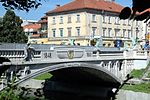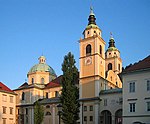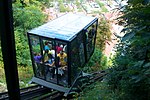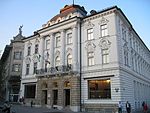Butchers' Bridge

The Butchers' Bridge (Slovene: Mesarski most) is a footbridge crossing the river Ljubljanica in Ljubljana, the capital of Slovenia. It connects the Ljubljana Central Market and the Petkovšek Embankment (Petkovškovo nabrežje). The bridge was solemnly opened on 10 July 2010. The original idea for a bridge on the site was expressed in the 1930s by the architect Jože Plečnik. The modern bridge, which is far more simple than the original plan, features a staircase at its left entry, a glass walking belts at the sides, and two fences with steel wires and wide top shelves. It was designed by Jurij Kobe from the Atelier Arhitekti studio. It is decorated with works by the sculptor Jakov Brdar.
Excerpt from the Wikipedia article Butchers' Bridge (License: CC BY-SA 3.0, Authors, Images).Butchers' Bridge
Vodnik square, Ljubljana Trnovo
Geographical coordinates (GPS) Address External links Nearby Places Show on map
Geographical coordinates (GPS)
| Latitude | Longitude |
|---|---|
| N 46.051761111111 ° | E 14.508761111111 ° |
Address
Mesarski most
Vodnik square
1104 Ljubljana, Trnovo
Slovenia
Open on Google Maps









